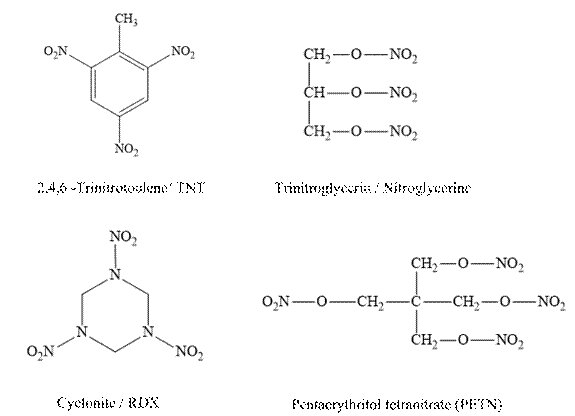
Concept explainers
Interpretation:
The molecular weight of each explosive in this chemical connection should be determined along with identify which explosive do the nitro groups contribute the largest percentage of molecular weight.
Concept Introduction:
The following explosives are present in the chemical connections.

Answer to Problem 13.41P
Molecular weight of TNT is
Molecular weight of nitroglycerine is.
Molecular weight of cyclonite is.
Molecular weight of pentaerythritol is
Therefore, cyclonite has high percentage contribution of nitro group in their molecular weight.
Explanation of Solution
Molecular weight of TNT (
Atomic weight of total number of carbon atoms =
Atomic weight of total number of hydrogen atoms =
Atomic weight of total number of nitrogen atoms =
Atomic weight of total number of oxygen atoms =
Molecular weight =
Therefore, molecular weight of TNT is
Percentage composition of
TNT has three
Weight of.
Therefore, the percentage contribution of.
Percentage contribution of nitrogen in TNT:
TNT has three nitrogens.
Therefore, the percentage contribution of nitrogen in TNT is.
Molecular weight of nitroglycerine (
Atomic weight of total number of carbon atoms =
Atomic weight of total number of hydrogen atoms =
Atomic weight of total number of nitrogen atoms =
Atomic weight of total number of oxygen atoms =
Molecular weight =
Therefore, molecular weight of nitroglycerine is
Percentage composition of
Nitroglycerine has three
Weight of.
Therefore, the percentage contribution of.
Percentage contribution of nitrogen in nitroglycerine:
Nitroglycerine has three nitrogens.
Therefore, the percentage contribution of nitrogen in nitroglycerine is
Molecular weight of cyclonite (
Atomic weight of total number of carbon atoms =.
Atomic weight of total number of hydrogen atoms =.
Atomic weight of total number of nitrogen atoms =
Atomic weight of total number of oxygen atoms =
Molecular weight =
Therefore, molecular weight of cyclonite is
Percentage composition of
Cyclonite has three
Weight of
Therefore, the percentage contribution of.
Percentage contribution of nitrogen in cyclonite:
Cyclonite has six nitrogens.
Therefore, the percentage contribution of nitrogen in cyclonite is.
Molecular weight of pentaerythritol (
Atomic weight of total number of carbon atoms =
Atomic weight of total number of hydrogen atoms =
Atomic weight of total number of nitrogen atoms =
Atomic weight of total number of oxygen atoms =.
Molecular weight =
Therefore, molecular weight of pentaerythritol is
Percentage composition of
Pentaerythritol has four
Weight of
Therefore, the percentage contribution of
Percentage contribution of nitrogen in pentaerythritol
Pentaerythritol has four nitrogens.
Therefore, the percentage contribution of nitrogen in pentaerythritol is
Molecular weight of TNT is
Molecular weight of nitroglycerine is
Molecular weight of cyclonite is
Molecular weight of pentaerythritol is
Therefore, cyclonite has high percentage contribution of nitro group in their molecular weight.
Want to see more full solutions like this?
Chapter 13 Solutions
Introduction to General, Organic and Biochemistry
- 13-36 (Chemical Connections 13A, Would you expect DDT to be soluble or insoluble in water? Explain.arrow_forward13-39 (Chemical Connections 13B) What is a carcinogen What kind of carcinogen is found in cigarette smoke?arrow_forward13-20 Three products with the molecular formula CgH^BrCl form when bromobenzene is treated with chlorine, Cl2, in the presence of FeCl3 as a catalyst. Name and draw a structural formula for each product.arrow_forward
- 13-34 (Chemical Connections 13A) From what parts of its common name are the letters DDT derived?arrow_forward13-52 2,6-Di-/ezY-butyl-4-methylphenol (BHT, Section 13-4C) is an antioxidant added to processed foods to “retard spoilage.” How does BHT accomplish this goal?arrow_forward13-43 (Chemical Connections 13E) Which features of Allura Red and Sunset Yellow make them water-soluble?arrow_forward
- 13-49 (Chemical Connections 13F) In what ways is capsaicin used in medicine?arrow_forward14-66 1,4-Butanediol, hexane, and 1-pentanol have similar molecular weights. Their boiling points, arranged from lowest to highest, are 69°C, 138°C, and 230°C. Which compound has which boiling point?arrow_forward13-57 Benzene, as we have seen in this chapter, is the simplest aromatic compound. Pyidine is an analog of benzene in which a CH group is replaced by a nitrogenarrow_forward
- 13-19 Suppose you have unlabeled bottles of benzene and cyclohexene. What chemical reaction could you use to tell which bottle contains which chemical? Explain what you would do, what you would expect to see, and how you would explain your observations. Write an equation for a positive test.arrow_forward13-48 (Chemical Connections 13F, How many cis-trans isomers are possible for capsaicin? Is the structural formula shown in this Chemical Connection the cis isomer or the trans isomer?arrow_forward13-31 What structural features are common to vitamin E, BHT, and BHA (the three antioxidants presented in Section 13-40?arrow_forward
 Introduction to General, Organic and BiochemistryChemistryISBN:9781285869759Author:Frederick A. Bettelheim, William H. Brown, Mary K. Campbell, Shawn O. Farrell, Omar TorresPublisher:Cengage Learning
Introduction to General, Organic and BiochemistryChemistryISBN:9781285869759Author:Frederick A. Bettelheim, William H. Brown, Mary K. Campbell, Shawn O. Farrell, Omar TorresPublisher:Cengage Learning
